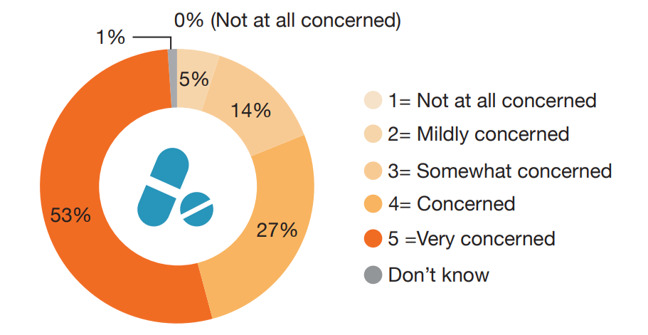October 26, 2017
President Donald Trump declared the nation’s opioid crisis a “public health emergency,” underscoring employer concerns with this growing epidemic. Past instances of public health emergencies in the U.S. include the H1N1 influenza outbreak in 2009, as well as severe weather events and natural disasters.
The Washington Post reported that the declaration will “waive some regulations, give states more flexibility in how they use federal funds and expand the use of telemedicine treatment.”In making the declaration, the President announced he is “directing every agency to use every appropriate emergency authority to fight to opioid crisis,” and that the Department of Health and Human Services (HHS) would begin by updating pain management best practices.
Prior to the declaration, employers were already increasingly seeking ways to reduce the inappropriate use/ abuse of prescription opioids. According to Business Group on Health’s Large Employers’ 2018 Health Care Strategy And Plan Design Survey, the vast majority of employers (80%) are concerned about inappropriate use and abuse of prescription opioids, with 53% stating they are very concerned. Thirty percent have restrictions in place for prescription opioids, and 21% have programs in place to manage prescription opioid use.
Concern Over Inappropriate Use/Abuse of Prescription Opioids

Why Your CEO May Care
Your CEO may want to know how the misuse and abuse of opioids could impact employee productivity, workplace costs, absenteeism and disability costs, workers compensation claims, overall medical expenses, and the labor participation rate.
- Opioid abuse costs the U.S. economy nearly $78.5 billion a year, 30% of which is directly attributable to health care costs[i] and nearly 2 million Americans are abusing prescription opioids.[ii]
- Lost workplace productivity costs contributed the largest share of total societal costs associated with opioid abuse, amounting to approximately $25.6 billion.[iii]
- Of workplace costs, premature death was the largest component, accounting for $11.2 billion (43.8%), and lost wages/employment and presenteeism were the next two costliest components, contributing $7.9 billion (31.0%) and $2.0 billion (8.0%), respectively.[iv]
- Employees with opioid abuse accounted for 64.5% and 90.1% of excess medically related absenteeism and disability costs, while caregivers contributed the remaining 35.5% and 9.9%, respectively.[v]
- Sales of prescription opioids in the U.S. nearly quadrupled from 1999 to 2014.[vi]
- From 2007 – 2012, the rate of opioid prescribing steadily increased among specialists more likely to manage acute and chronic pain. Prescribing rates are highest among pain medicine (49%), surgery (37%), and physical medicine/rehabilitation (36%). However, primary care providers account for about half of opioid pain relievers dispensed.[vii]
- A recent report from the Federal Reserve has suggested that sustained economic stagnation may be partly attributable to employees’ inability to pass preemployment screenings such as drug tests.[viii]
- Finally, although America claims less than 5% of the world’s population, it consumes roughly 80% of the world’s opioid supply.[ix]
What Large Employers Are Doing
Large employers are already taking numerous steps to address the inappropriate use/abuse of prescription opioids in the workforce. According to the Business Group's Large Employers’ Health Care Strategy And Plan Design Survey, employers are working directly with their health plans and PBMs to address the issue using the following strategies:
- Approving a limited supply of opioids;
- Limiting coverage of opioids to a network of pharmacies and/or providers;
- Ensuring coverage of alternatives for pain management such as physical therapy;
- Providing training in the workplace to increase awareness and recognition of symptoms;
- Working with their health plans to encourage physicians to communicate about the dangers of opioids and to encourage physicians who are prescribing more frequently than expected to change prescribing patterns and consider alternatives for pain management.
Additionally, behavioral health is a growing area of focus among employers and companies are making attempts to improve access and reduce the stigma associated with behavioral health treatment.
- 56% of companies will offer telebehavioral health in 2018, more than a 50% increase in the number of companies providing it this year.
- 20% of companies will offer self-directed online cognitive behavioral therapy in 2018, up from 8% this year.
- Many large employers will offer manager and employee training to help build broader awareness and sensitivity to help employees recognize behavioral health issues in the workforce and provide tips on how to reach out to their colleagues and direct them to appropriate resources.
- In addition, 18% of employers will hold anti-stigma campaigns for behavioral health conditions.
Sources
1 Opioid Epidemic Costs U.S. $78.5 Billion Annually: CDC (no date). Available at: http://www.health.com/healthday/opioid-epidemic-costs-us-785-billion-annually-cdc (Accessed: 26 October 2017).
2 “The Opioid Crisis,” Castlight Health, accessed July 14, 2016, http://www.castlighthealth.com/typ/the-opioid-crisis/.
3 Howard G. Birnbaum et al., “Societal Costs of Prescription Opioid Abuse, Dependence, and Misuse in the United States,” Pain Medicine 12, no. 4 (April 1, 2011): 657–67, doi:10.1111/j.1526-4637.2011.01075.x.
4 Ibid.
5 Ibid.
6 Centers for Disease Control and Prevention. Vital Signs: Overdoses of Prescription Opioid Pain Relievers — United States, 1999—2008. MMWR 2011; 60(43);1487-1492.
7 Daubresse M, Chang H, Yu Y, Viswanathan S, et al. Ambulatory diagnosis and treatment of nonmalignant pain in the United States, 2000 – 2010. Medical Care 2013; 51(10): 870-878. http://dx.doi.org/10.1097/MLR.0b013e3182a95d86
8 Cheng, E. (2017–400) Opioid crisis keeping US from reaching full employment: Goldman. Available at: https://www.cnbc.com/2017/07/06/opioid-crisis-keeping-us-from-reaching-full-employment-goldman.html (Accessed: 26 October 2017).
9 A Nation in Pain | Express Scripts (no date). Available at: http://lab.express-scripts.com/lab/publications/a-nation-in-pain (Accessed: 26 October 2017).
More Topics
Articles & Guides
This content is for members only. Already a member?
Login
![]()
